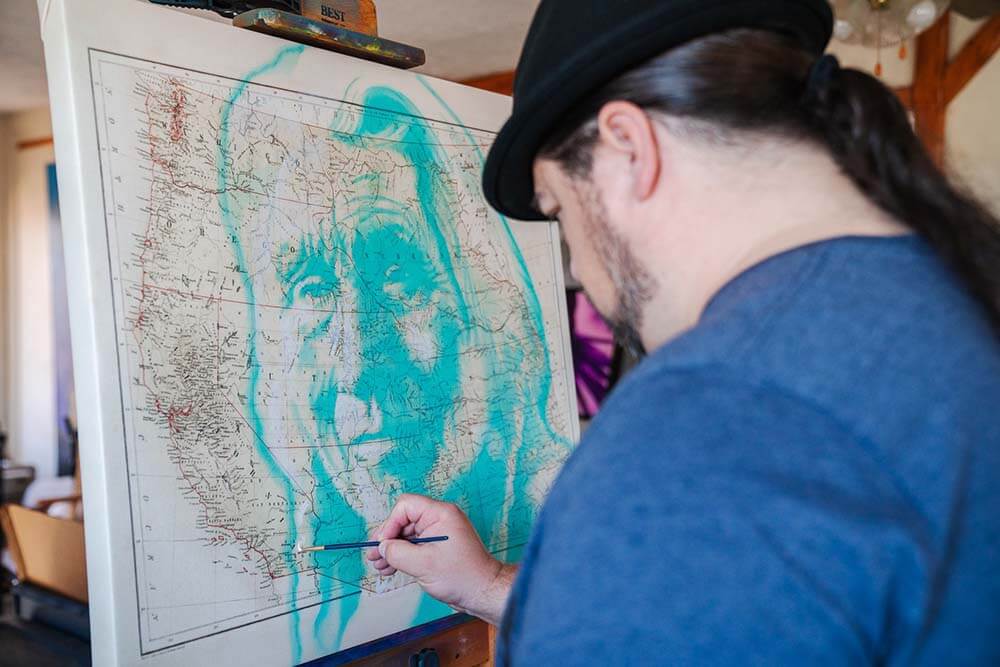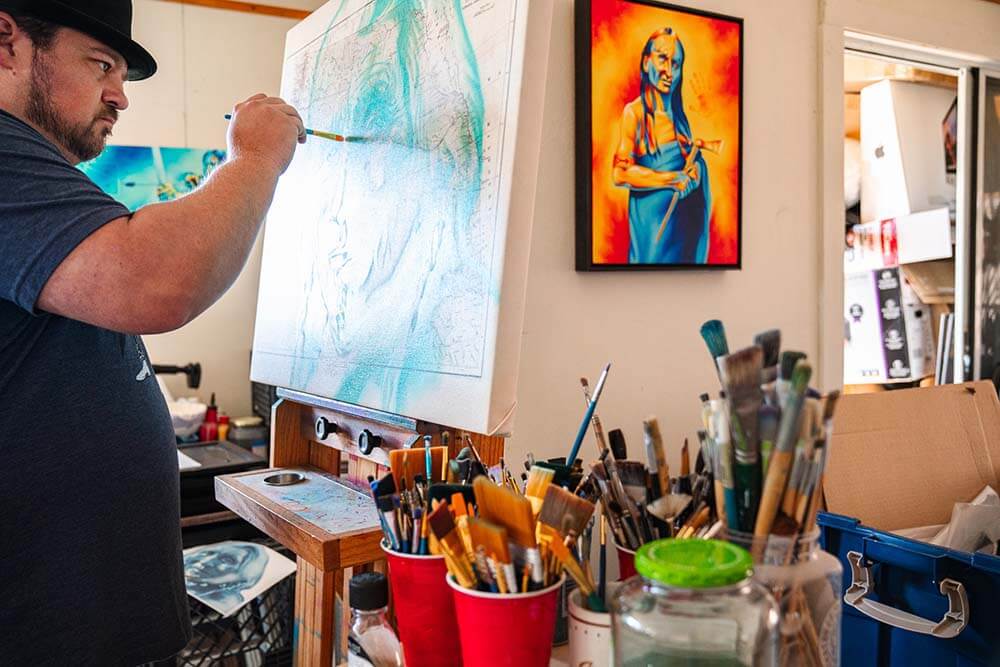Artist Robert Martinez draws from his Northern Arapaho and Chicano roots to tell unexpected stories through his art. Recently, Martinez worked on a piece to commemorate Yellowstone National Park’s 150th anniversary. Learn more about this Wyoming artist and what inspires his work.
Where in Wyoming do you live and why do you choose to live there?
I live in the central Wyoming on the Wind River Reservation, and I choose to live here because my family’s been here for many generations. Historically, the Northern Arapaho were placed on this reservation in central Wyoming. And the Plains tribes have called this place home as well. My mother’s family grew up here, was here forever. My father’s family came here in the ’30s and then grew up here. So for many generations we’ve lived in this area.

What about this particular place speaks to you as an artist?
Central Wyoming has always been my home, and it’s been the home of my family for generations. So growing up as a person from Wyoming, you do take for granted the, scenery. But the thing that really keeps me here is the people. My artwork focuses mainly on people and the things surrounding them. It communicates different things about them, and especially about native people. That’s what really centers me to this area.
What drew you to your medium of artwork?
The style I often use and that I created for the Yellowstone project is the ledger art tradition. For those that aren’t aware, ledger art was an art form that came out of indigenous tribes being pushed onto reservations and the extermination of the buffalo. We couldn’t get our traditional hides from buffalo or elk to make what’s known as a winter count or commemorative event hides. Depending on the tribe, we would trade for, or were given, specific pieces of paper, like old ledgers. We would disregard the background and we would paint and draw over those. It became a tradition with Plains tribes, and it’s carried on to this day.

My work takes that tradition in a little bit of a different direction. I use a background in many of my pieces. The specific piece that I did for Yellowstone’s 150th was an actual map of Yellowstone. On that, I created an image of one of the Northern Arapaho leaders – Yellow Calf – and added Buffalo and elk to include the wildlife element on the actual map, signifying the land. So you have the wildlife, you have the landscape, and then you have the people, which is my main focus.
How has Yellowstone inspired you as an artist? Can you tell us more about your Yellowstone 150 piece?
I don’t know that Yellowstone has itself inspired me, however, the land around it was, and historically is, claimed by many native indigenous tribes. My tribe – the Northern Arapaho – being one of those. The translation we have for Yellowstone is “the water goes up,” which I think Is a cool translation. I know that historically my family members have been there and seen that. The fact that the national park service and Wyoming really want to highlight the indigenous impact and historical claim to Yellowstone is great. And I think it’s long overdue.

My piece first and foremost highlights the native people. That’s why I put that figure center and front. The native tribes of the Americas were the first stewards of the land. And we always view wildlife and nature and our Mother Earth that way. But that specific story has not been told by
indigenous people to other people. It’s been told about us, but not from us. So I wanted to at least start that story from one indigenous person to everybody.
What is your most memorable experience of Yellowstone National Park and why?
My most memorable experience was when I was about 12. My mom and my dad took my sisters and I to Old Faithful. Like, you know, you gotta go see Old Faithful. We saw lots of wildlife and other than Old Faithful, what I really remember is the tourist traffic. It was memorable, but a very interesting dichotomy. In the middle of this beautiful landscape you could have bumper to bumper traffic on the way to see some amazing natural vistas and geysers and things of that nature.
Earlier you mentioned that a lot of indigenous people get their stories told for them. Would you like to expand on that?
Sure. Native people here in the Americas, their image and their symbols and stories have been told by non-indigenous people for a huge amount of time now. And it continues that way. There are a great number of nonnative artists creating native imagery who have a longer and more lucrative career than actual native artists. The same can’t be said for another kind of people there.

For instance, there are probably not a bunch of non-Asian artists creating Asian work, or non-African artist creating African American work, but there seems an inordinate amount of non-indigenous artists doing that. I have to question why that is. The native artists I know are awesome. They do great work. They do singular work. Why is that not highlighted? Why is a story always being told by other people? It’s changing slowly. But the ability to tell our own stories through our own imagery or our own sculpture or our own plays or our own TV shows, until now, it hasn’t been available. I would like to see more indigenous people telling their own stories. I think that’s a conversation that needs to continue.
Is there anything else you want to say about yourself or your artwork?
There’s not really anything else I want to say about me in particular or my art, but there is a little bit I’d like to say about stereotypes of native people. There are some misconceptions when meeting or talking with or seeing actual people from indigenous tribes in north America. There’s a lot to unpack with that. When people think of natives, they think of one thing and it’s usually Plains Indian culture. I believe there are over 500 indigenous tribes in the continental U.S. by themselves. And each has their own culture. Each has their own language, their own specific dress, their own ceremonies. And they’re all different. People tend to think of us as one thing.

If you go back to 5th grade geography and you look at map of Europe, France and Spain are right next to each other, but they have different languages. They have different dress, they have a whole different history, a different culture. People can understand that when it comes to those
countries, but we had the same here on the continental Americas; we were all different. So adjust your expectations. About native people, who they are, what they are, what they look like and the art that they do.
Is there anything you’d like to achieve with your art?
I would like my art to be received. I would like people to first be interested, and then have that communication, whatever that is, come through. My job as an artist is to communicate something – an idea, or highlight an issue, or, at the very least, communicate some aesthetic that’s visually striking to the viewer. And if I’m doing my job, that comes through. If I’m not doing my job, then it gets muddied. But that’s pretty much it. First and foremost. And then of course, you know, geez, I hope you like it enough to take it home with you.
During the summer of 2022, you can find Robert Martinez’s Yellowstone 150th piece in the form of a free poster in the Northern Arapaho Experience Culture Room at the Wind River Hotel & Casino. Learn more about his artwork here.